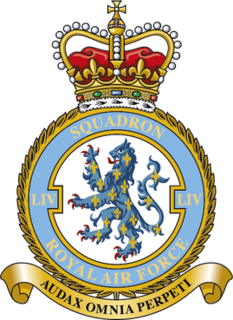No. 155 Squadron RAF is a former Royal Air Force squadron.

Number 54 Squadron is a squadron of the Royal Air Force. It is based at RAF Waddington, England. On 1 September 2005 it took on the role of Intelligence, Surveillance and Reconnaissance (ISR) Operational Conversion Unit, responsible for training all RAF crews assigned to the E-3D Sentry AEW1 and the Nimrod R1 and the Sentinel R1 as well as running the Qualified Weapons Instructor Intelligence, Surveillance and Reconnaissance Course. The squadron was previously a SEPECAT Jaguar strike fighter unit, operating from RAF Coltishall, until it was disbanded on 11 March 2005. Since September 2005 the unit has been formally titled 54(Reserve) Squadron, until the (Reserve) nameplate was removed from all training squadrons in 2018.
No. 610 Squadron of the Royal Air Force was a Squadron of the Auxiliary Air Force. Comprising very high quality pilots, often ex-RAF officers and occasionally locally based company Test pilots from companies such as de Havilland and Airwork. Its pilots were initially part timers who would spend their weekends and spare time flying and practising combat manoeuvres. The squadron was named the "County of Chester" and adopted the motto "Alifero tollitur axe ceres"; which translates as "Ceres rising in a winged chariot". Ceres being the Roman Goddess of Wheat, a reference to Chester's Agricultural sector. Its badge contained the image of a garb.

Number 332 Squadron of the Royal Air Force was formed at RAF Catterick in the North Riding of Yorkshire on 16 January 1942, as a Supermarine Spitfire-equipped fighter squadron manned by Norwegians.

No. 331 Squadron RAF was a Second World War squadron of the Royal Air Force. The squadron was primarily manned with Norwegian aircrew. The squadron was part of Fighter Command between 1941 and March 1944 when it joined the 2nd Tactical Air Force until the end of the war. The squadron took part in the Dieppe Raid and the Normandy landings.

No. 313 Squadron RAF was a Czechoslovak-manned fighter squadron of the Royal Air Force in the Second World War.

No. 452 Squadron is a Royal Australian Air Force (RAAF) air traffic control unit. It was established in 1941 as a fighter squadron, in accordance with Article XV of the Empire Air Training Scheme during World War II. The squadron flew Supermarine Spitfires for the entire war, initially over the United Kingdom and Nazi-occupied Europe. It was later based in Australia and the Netherlands East Indies, before being disbanded in 1945. It was re-raised in its current role in February 2011.

RAF Horsham St Faith is a former Royal Air Force station near Norwich, Norfolk, England which was operational from 1939 to 1963. It was then developed as Norwich International Airport.

402 "City of Winnipeg" Squadron is a Royal Canadian Air Force squadron based in Winnipeg, Manitoba, Canada

Number 63 Squadron was a bomber aircraft and training squadron of the Royal Air Force that was active during various periods from 1916 to 1992. Originally using De Havilland DH4 aircraft in World War I, it was last equipped with BAe Hawk jet trainers.
No. 122 (Bombay) Squadron was a Royal Air Force fighter squadron during the First and Second World Wars.

No. 266 (Rhodesia) Squadron RAF was a squadron of the Royal Air Force.

No. 457 Squadron was a Royal Australian Air Force (RAAF) fighter squadron of World War II. Equipped with Supermarine Spitfire fighters, it was formed in England during June 1941 under Article XV of the Empire Air Training Scheme. The squadron was transferred to Australia in June 1942 and saw combat in the South West Pacific Area before being disbanded in November 1945.

349th Squadron is a fighter squadron in the Air Component of the Belgian Armed Forces. The squadron traces its origins to No. 349 (Belgian) Squadron of the Royal Air Force, founded in 1942 as part of the Free Belgian forces during World War II. It was transferred to the re-established Belgian Air Force in 1946, together with 350th Squadron. Considered a "honorary" squadron, it retained its original name and numbering and has been flying under the Belgian flag ever since. Today it is part of the 10th Tactical Wing, operating the F-16 Fighting Falcon from Kleine Brogel airbase.
No. 225 Squadron RAF is a former Royal Air Force squadron.
No. 145 Squadron was a Royal Air Force squadron that operated during World War I, World War II and the Cold War.
No. 243 Squadron was a flying squadron of the Royal Air Force. Originally formed in August 1918 from two flights that had been part of the Royal Naval Air Service, the squadron conducted anti-submarine patrols during the final stages of World War I. The squadron was later re-raised during World War II, operating initially as a fighter squadron in Malaya and Singapore during 1941–42. It was briefly disbanded just prior to the fall of Singapore, and was re-formed in mid-1942, again as a fighter squadron, and fought in the Tunisian and Italian campaigns in 1942–44, before being disbanded in October 1944. In 1945, after training on transport aircraft in Canada, the squadron moved to Australia where it operated in support of the British Pacific Fleet before disbanding in mid-1946.
No. 167 Squadron RAF is a former Royal Air Force squadron.

No. 411 "City of York" Squadron RCAF was a Second World War Royal Canadian Air Force squadron that operated as part of RAF Fighter Command in Europe with the Supermarine Spitfire.

No. 130 Squadron of the Royal Air Force was a Second World War and Cold war fighter squadron, and later a strategic missile squadron.













